Answered step by step
Verified Expert Solution
Question
1 Approved Answer
this is a management decision making class... i need to do this practice but i dont understand anything. please be clear with the work. show
this is a management decision making class...
i need to do this practice but i dont understand anything. please be clear with the work. show work 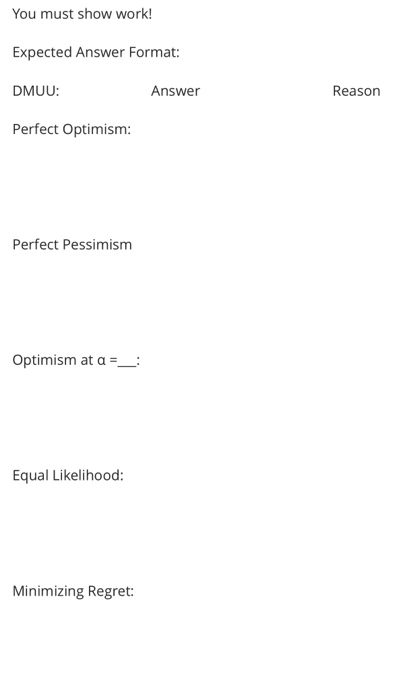

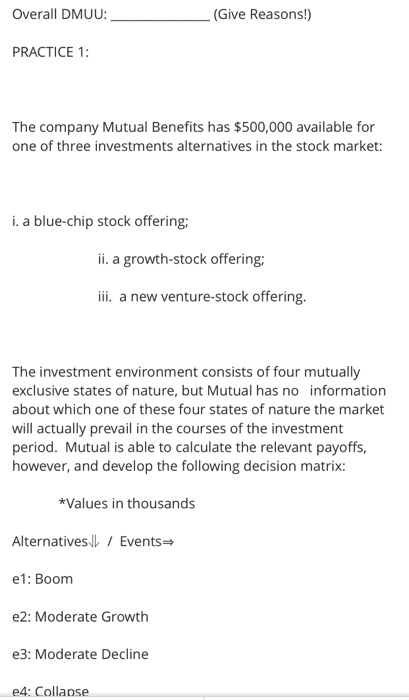

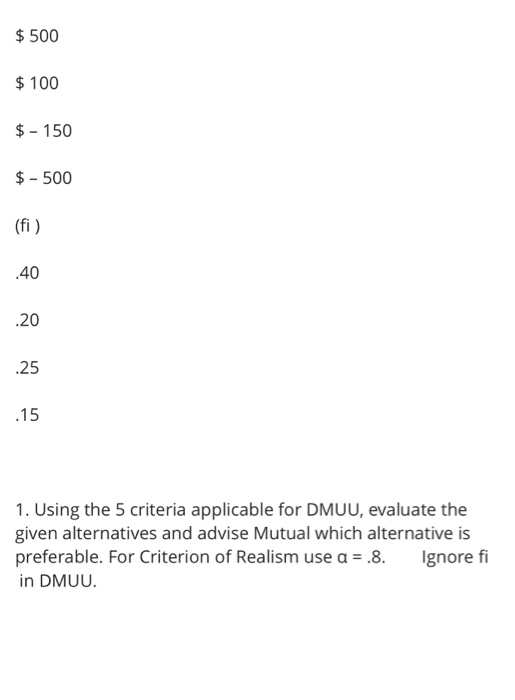
im not sure too. and the professor is not too good 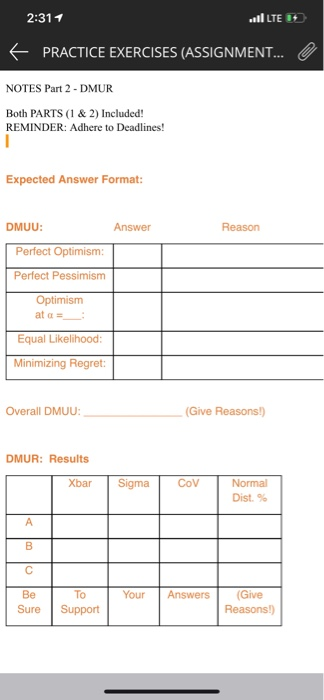

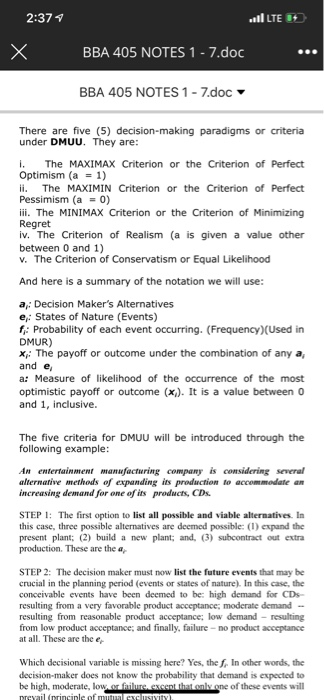
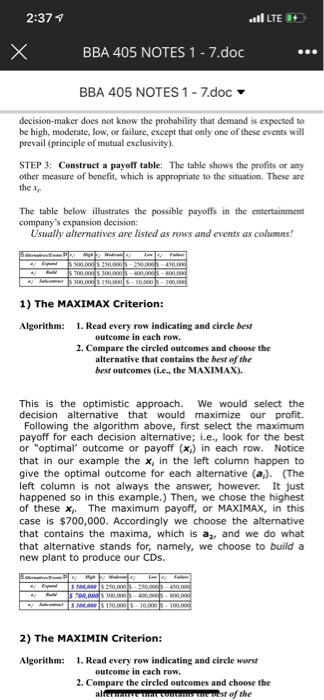
You must show work! Expected Answer Format: DMUU: Answer Reason Perfect Optimism: Perfect Pessimism Optimism at a =__: Equal Likelihood: Minimizing Regret: Overall DMUU: (Give Reasons!) PRACTICE 1: The company Mutual Benefits has $500,000 available for one of three investments alternatives in the stock market: i. a blue-chip stock offering; ii. a growth-stock offering; iii. a new venture-stock offering. The investment environment consists of four mutually exclusive states of nature, but Mutual has no information about which one of these four states of nature the market will actually prevail in the courses of the investment period. Mutual is able to calculate the relevant payoffs, however, and develop the following decision matrix: *Values in thousands Alternatives i / Events e1: Boom e2: Moderate Growth e3: Moderate Decline e4: Collapse e4: Collapse a1: Blue Chip $ 250 $ 75 $0 $ - 300 a2: Growth $ 375 $ 150 $ - 50 $ - 400 a3: Venture $ 500 $ 100 $ - 150 $ - 500 (fi) $ 500 $ 100 $ - 150 $-500 (fi) 1. Using the 5 criteria applicable for DMUU, evaluate the given alternatives and advise Mutual which alternative is preferable. For Criterion of Realism use a = .8. Ignore fi in DMUU. 2:311 vil E + E PRACTICE EXERCISES (ASSIGNMENT... O NOTES Part 2 - DMUR Both PARTS (1 & 2) Included! REMINDER: Adhere to Deadlines! Expected Answer Format: DMUU: Answer Reason Perfect Optimism: Perfect Pessimism Optimism at a =_ Equal Likelihood: Minimizing Regret: Overall DMUU: (Give Reasons!) DMUR: Results Xbar Sigma COV Normal Dis Your Answers Be Sure To Support (Give Reasons!) 2:37 LTE x BBA 405 NOTES 1 - 7.doc ... BBA 405 NOTES 1 - 7.doc 2. Decision making under conditions of risk (DMUR): The decision-maker knows that the economy will be either in a state of recession, recovery, prosperity, or decline, but does not know which one of these four states of nature is likely to occur in the planning horizon. However, the decision-maker has reliable probabilities for each one of these events to occur. Let's say, there is 70% chance that the economy will be in recession, 25% likelihood that it will be in recovery, but only 5% probability that it will be in prosperity. Put differently, but the decision maker has knowledge not only about various states of nature, but also the probability of each one of these states of nature to occur. The decision then translates into determining the correct alternative with respect to the information about the occurrence of each the possible states of nature. (This will be the second method to be covered only because it is more complicated than the third method explicated immediately below.) 3. Decision making under conditions of uncertainty (DMUU): In this situation, the decision-maker knows that the economy will be either in a state of recession, recovery, or prosperity, mutually exclusively, but does not know or determine the probability of each of these three states of nature to occur in the planning horizon. This will be the first method to be covered in this course. There are five (5) decision-making paradigms or criteria under DMUU. They are: i. The MAXIMAX Criterion or the Criterion of Perfect Optimism (a = 1) ii. The MAXIMIN Criterion or the Criterion of Perfect Pessimism (a = 0) iii. The MINIMAX Criterion or the Criterion of Minimizing Regret iv. The Criterion of Realism (a is given a value other between 0 and 1) v. The Criterion of Conservatism or Equal Likelihood And here is a summary of the notation we will use: a: Decision Maker's Alternatives e: States of Nature (Events) f: Probability of each event occurring. (Frequency) (Used in DMUR) x,: The payoff or outcome under the combination of any a 2:37 LTE x BBA 405 NOTES 1 - 7.doc ... BBA 405 NOTES 1 - 7.doc There are five (5) decision-making paradigms or criteria under DMUU. They are: The MAXIMAX Criterion or the Criterion of Perfect Optimism (a = 1) ii. The MAXIMIN Criterion or the Criterion of Perfect Pessimism (a = 0) iii. The MINIMAX Criterion or the Criterion of Minimizing Regret iv. The Criterion of Realism (a is given a value other between 0 and 1) V. The Criterion of Conservatism or Equal Likelihood And here is a summary of the notation we will use: a: Decision Maker's Alternatives e: States of Nature (Events) f: Probability of each event occurring. (Frequency)(Used in DMUR) x: The payoff or outcome under the combination of any a, and e a: Measure of likelihood of the occurrence of the most optimistic payoff or outcome (x). It is a value between 0 and 1, inclusive. The five criteria for DMUU will be introduced through the following example: An entertainment manufacturing company is considering several alternative methods of expanding its production to accommodate an increasing demand for one of its products, CDs. STEP 1: The first option to list all possible and viable alternatives. In this case, three possible alternatives are deemed possible: (1) expand the present plant; (2) build a new plant; and, (3) subcontract out extra production. These are the a STEP 2: The decision maker must now list the future events that may be crucial in the planning period (events or states of nature). In this case, the conceivable events have been deemed to be: high demand for CDs resulting from a very favorable product acceptance; moderate demand- resulting from reasonable product acceptance: low demand - resulting from low product acceptance, and finally, failure - no product acceptance at all. These are the e Which decisional variable is missing here? Yes, the f. In other words, the decision-maker does not know the probability that demand is expected to be high, moderate, low.cor. re excent that only one of these events will prevail (principle of mutual en Sivity 2:374 LTE x B BA 405 NOTES 1 - 7.doc ... BBA 405 NOTES 1 - 7.doc decision-maker does not know the probability that demand is expected to be high, moderate, low, or failure, except that only one of these events will prevail (principle of mutual exclusivity). STEP 3: Construct a payoff table: The table shows the profits or any other measure of benefit, which is appropriate to the situation. These are the x The table below illustrates the possible payoffs in the entertainment company's expansion decision: Usually alternatives are listed as rows and events as columns 1) The MAXIMAX Criterion: Algorithm: 1. Read every row indicating and circle best outcome in each row. 2. Compare the circled outcomes and choose the alternative that contains the best of the best outcomes (i.c., the MAXIMAX). This is the optimistic approach. We would select the decision alternative that would maximize our profit. Following the algorithm above, first select the maximum payoff for each decision alternative; i.e., look for the best or "optimal outcome or payoff (x) in each row. Notice that in our example the x, in the left column happen to give the optimal outcome for each alternative (a). (The left column is not always the answer, however. It just happened so in this example.) Then, we chose the highest of these x The maximum payoff, or MAXIMAX, in this case is $700,000. Accordingly we choose the alternative that contains the maxima, which is az, and we do what that alternative stands for, namely, we choose to build a new plant to produce our CDs. PAW S250 $70,0 300.000 - 100.000-00000 S M S ISO.000 - 10.000 - 100.000 2) The MAXIMIN Criterion: Algorithm: 1. Read every row indicating and circle worst outcome in each row, 2. Compare the circled outcomes and choose the alter s west of the You must show work! Expected Answer Format: DMUU: Answer Reason Perfect Optimism: Perfect Pessimism Optimism at a =__: Equal Likelihood: Minimizing Regret: Overall DMUU: (Give Reasons!) PRACTICE 1: The company Mutual Benefits has $500,000 available for one of three investments alternatives in the stock market: i. a blue-chip stock offering; ii. a growth-stock offering; iii. a new venture-stock offering. The investment environment consists of four mutually exclusive states of nature, but Mutual has no information about which one of these four states of nature the market will actually prevail in the courses of the investment period. Mutual is able to calculate the relevant payoffs, however, and develop the following decision matrix: *Values in thousands Alternatives i / Events e1: Boom e2: Moderate Growth e3: Moderate Decline e4: Collapse e4: Collapse a1: Blue Chip $ 250 $ 75 $0 $ - 300 a2: Growth $ 375 $ 150 $ - 50 $ - 400 a3: Venture $ 500 $ 100 $ - 150 $ - 500 (fi) $ 500 $ 100 $ - 150 $-500 (fi) 1. Using the 5 criteria applicable for DMUU, evaluate the given alternatives and advise Mutual which alternative is preferable. For Criterion of Realism use a = .8. Ignore fi in DMUU. 2:311 vil E + E PRACTICE EXERCISES (ASSIGNMENT... O NOTES Part 2 - DMUR Both PARTS (1 & 2) Included! REMINDER: Adhere to Deadlines! Expected Answer Format: DMUU: Answer Reason Perfect Optimism: Perfect Pessimism Optimism at a =_ Equal Likelihood: Minimizing Regret: Overall DMUU: (Give Reasons!) DMUR: Results Xbar Sigma COV Normal Dis Your Answers Be Sure To Support (Give Reasons!) 2:37 LTE x BBA 405 NOTES 1 - 7.doc ... BBA 405 NOTES 1 - 7.doc 2. Decision making under conditions of risk (DMUR): The decision-maker knows that the economy will be either in a state of recession, recovery, prosperity, or decline, but does not know which one of these four states of nature is likely to occur in the planning horizon. However, the decision-maker has reliable probabilities for each one of these events to occur. Let's say, there is 70% chance that the economy will be in recession, 25% likelihood that it will be in recovery, but only 5% probability that it will be in prosperity. Put differently, but the decision maker has knowledge not only about various states of nature, but also the probability of each one of these states of nature to occur. The decision then translates into determining the correct alternative with respect to the information about the occurrence of each the possible states of nature. (This will be the second method to be covered only because it is more complicated than the third method explicated immediately below.) 3. Decision making under conditions of uncertainty (DMUU): In this situation, the decision-maker knows that the economy will be either in a state of recession, recovery, or prosperity, mutually exclusively, but does not know or determine the probability of each of these three states of nature to occur in the planning horizon. This will be the first method to be covered in this course. There are five (5) decision-making paradigms or criteria under DMUU. They are: i. The MAXIMAX Criterion or the Criterion of Perfect Optimism (a = 1) ii. The MAXIMIN Criterion or the Criterion of Perfect Pessimism (a = 0) iii. The MINIMAX Criterion or the Criterion of Minimizing Regret iv. The Criterion of Realism (a is given a value other between 0 and 1) v. The Criterion of Conservatism or Equal Likelihood And here is a summary of the notation we will use: a: Decision Maker's Alternatives e: States of Nature (Events) f: Probability of each event occurring. (Frequency) (Used in DMUR) x,: The payoff or outcome under the combination of any a 2:37 LTE x BBA 405 NOTES 1 - 7.doc ... BBA 405 NOTES 1 - 7.doc There are five (5) decision-making paradigms or criteria under DMUU. They are: The MAXIMAX Criterion or the Criterion of Perfect Optimism (a = 1) ii. The MAXIMIN Criterion or the Criterion of Perfect Pessimism (a = 0) iii. The MINIMAX Criterion or the Criterion of Minimizing Regret iv. The Criterion of Realism (a is given a value other between 0 and 1) V. The Criterion of Conservatism or Equal Likelihood And here is a summary of the notation we will use: a: Decision Maker's Alternatives e: States of Nature (Events) f: Probability of each event occurring. (Frequency)(Used in DMUR) x: The payoff or outcome under the combination of any a, and e a: Measure of likelihood of the occurrence of the most optimistic payoff or outcome (x). It is a value between 0 and 1, inclusive. The five criteria for DMUU will be introduced through the following example: An entertainment manufacturing company is considering several alternative methods of expanding its production to accommodate an increasing demand for one of its products, CDs. STEP 1: The first option to list all possible and viable alternatives. In this case, three possible alternatives are deemed possible: (1) expand the present plant; (2) build a new plant; and, (3) subcontract out extra production. These are the a STEP 2: The decision maker must now list the future events that may be crucial in the planning period (events or states of nature). In this case, the conceivable events have been deemed to be: high demand for CDs resulting from a very favorable product acceptance; moderate demand- resulting from reasonable product acceptance: low demand - resulting from low product acceptance, and finally, failure - no product acceptance at all. These are the e Which decisional variable is missing here? Yes, the f. In other words, the decision-maker does not know the probability that demand is expected to be high, moderate, low.cor. re excent that only one of these events will prevail (principle of mutual en Sivity 2:374 LTE x B BA 405 NOTES 1 - 7.doc ... BBA 405 NOTES 1 - 7.doc decision-maker does not know the probability that demand is expected to be high, moderate, low, or failure, except that only one of these events will prevail (principle of mutual exclusivity). STEP 3: Construct a payoff table: The table shows the profits or any other measure of benefit, which is appropriate to the situation. These are the x The table below illustrates the possible payoffs in the entertainment company's expansion decision: Usually alternatives are listed as rows and events as columns 1) The MAXIMAX Criterion: Algorithm: 1. Read every row indicating and circle best outcome in each row. 2. Compare the circled outcomes and choose the alternative that contains the best of the best outcomes (i.c., the MAXIMAX). This is the optimistic approach. We would select the decision alternative that would maximize our profit. Following the algorithm above, first select the maximum payoff for each decision alternative; i.e., look for the best or "optimal outcome or payoff (x) in each row. Notice that in our example the x, in the left column happen to give the optimal outcome for each alternative (a). (The left column is not always the answer, however. It just happened so in this example.) Then, we chose the highest of these x The maximum payoff, or MAXIMAX, in this case is $700,000. Accordingly we choose the alternative that contains the maxima, which is az, and we do what that alternative stands for, namely, we choose to build a new plant to produce our CDs. PAW S250 $70,0 300.000 - 100.000-00000 S M S ISO.000 - 10.000 - 100.000 2) The MAXIMIN Criterion: Algorithm: 1. Read every row indicating and circle worst outcome in each row, 2. Compare the circled outcomes and choose the alter s west of the 



Step by Step Solution
There are 3 Steps involved in it
Step: 1

Get Instant Access to Expert-Tailored Solutions
See step-by-step solutions with expert insights and AI powered tools for academic success
Step: 2

Step: 3

Ace Your Homework with AI
Get the answers you need in no time with our AI-driven, step-by-step assistance
Get Started


